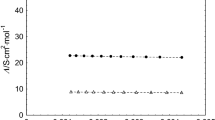Abstract
Conductances at 25.00°C are reported for the following systems: tetrabutylammonium bromide in dimethyl sulfoxide-acetone mixtures (Bu4NBr in Me2SO−Me2CO); tetraphenylphosphonium bromide (Ph4PBr) in water Me2SO, Me2CO, and in the mixtures H2O−Me2SO, Me2SO−Me2CO and Me2CO−H2O; Ph4PCl in Me2SO, Me2CO, H2O−Me2SO, and Me2SO−Me2CO; and tetrapropylammonium bromide (Pr4NBr) in Me2SO and Me2CO. The data were analyzed using the Fuoss 1978 equation which is based on the coupled equilibria: (unpaired ions)⇌(solvent-separated pairs)⇌(contact pairs). The conductimetric pairing constantK A =K R(l+K s) is the product of two factors:K R, which describes the first (diffusion controlled) equilibrium andK s=exp(−E s/kT), which describes the second (system-specific) equilibrium. Ions with overlapping cospheres (of diameterR) are defined as paired: their center-to-center distancer lies in the rangea≤r≤R; contact pairs (r=a) are ions which have one ion of opposite charge as a nearest neighbor, all other nearest and next nearest neighbors being solvent molecules. The quantityE s is the difference in free energy between the states defined byr=R andr=a. For the Me2SO−Me2CO systems,E s is positive for solutions in Me2SO and decreases through zero to negative values as the fraction of the less polarizable acetone increases. For solutions in waterE s is also positive. On addition of Me2SO or Me2CO,E s initially increases, goes through a maximum, and then decreases to negative values as the fraction of the less polarizable component increases. The decrease is an electrostatic effect, common to all the systems. The initial increase inE s appears when the small water molecules surrounding solvent-separated pairs are replaced by organic molecules which have greater volumes than water.
Similar content being viewed by others
References
R. M. Fuoss,J. Am. Chem. Soc. 80, 5059 (1958).
R. M. Fuoss,Proc. Natl. Acad. Sci. USA 75, 16 (1978).
R. M. Fuoss,J. Phys. Chem. 82, 2427 (1978).
S. Schiavo and B. Scrosati,Z. Phys. Chem. Neue Folge 102, 9 (1976).
S. Schiavo and G. Marrosu,Z. Phys. Chem. Neue Folge 105, 157 (1977).
D. E. Arrington and E. Griswold,J. Phys. Chem. 74, 123 (1970).
F. Accascina, S. Petrucci, and S. Schiavo,Sci. Tec. N. S. II, 27 (1958).
C. F. Lau, P. T. Wilson, and D. V. Fenby,Aust. J. Chem. 23, 1143 (1970).
M. A. Coplan and R. M. Fuoss,J. Phys. Chem. 68, 1180 (1964).
R. L. Kay and D. F. Evans,J. Phys. Chem. 70, 2325 (1966).
D. F. Evans, J. Thomas, J. A. Nadas, and M. A. Matesich,J. Phys. Chem. 75, 1714 (1971).
J. Hubbard and L. Onsager,J. Chem. Phys. 67, 4850 (1977).
J. Hubbard,J. Chem. Phys. 68, 1649 (1978).
Author information
Authors and Affiliations
Rights and permissions
About this article
Cite this article
Schiavo, S., Fuoss, R.M., Marrosu, G. et al. Ion pairing of quaternary salts in solvent mixtures. J Solution Chem 8, 557–571 (1979). https://doi.org/10.1007/BF00715996
Received:
Revised:
Issue Date:
DOI: https://doi.org/10.1007/BF00715996




